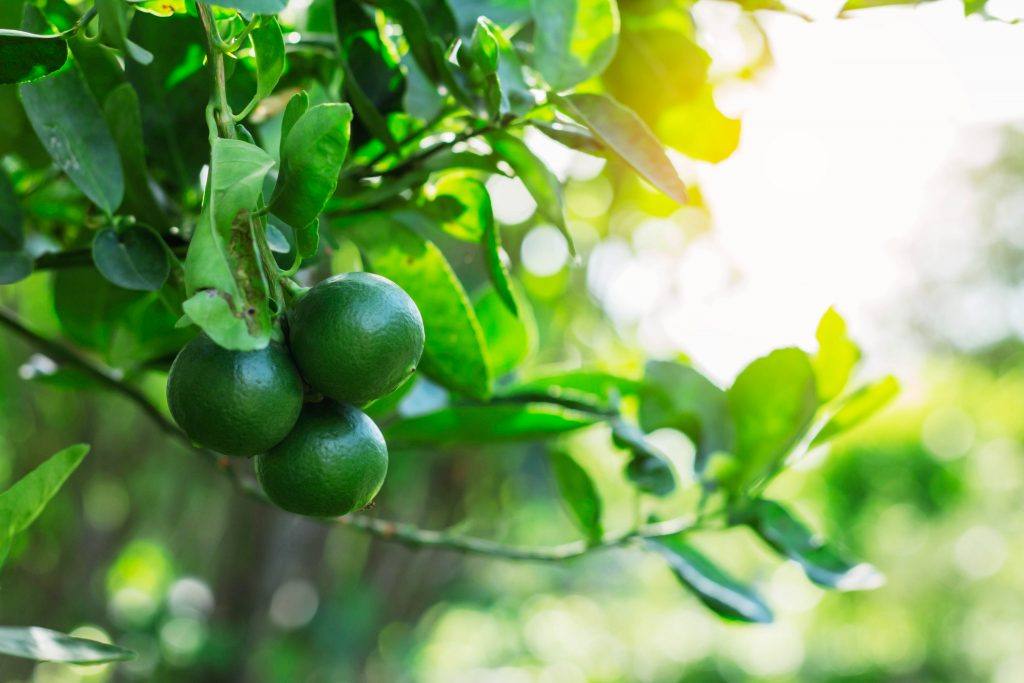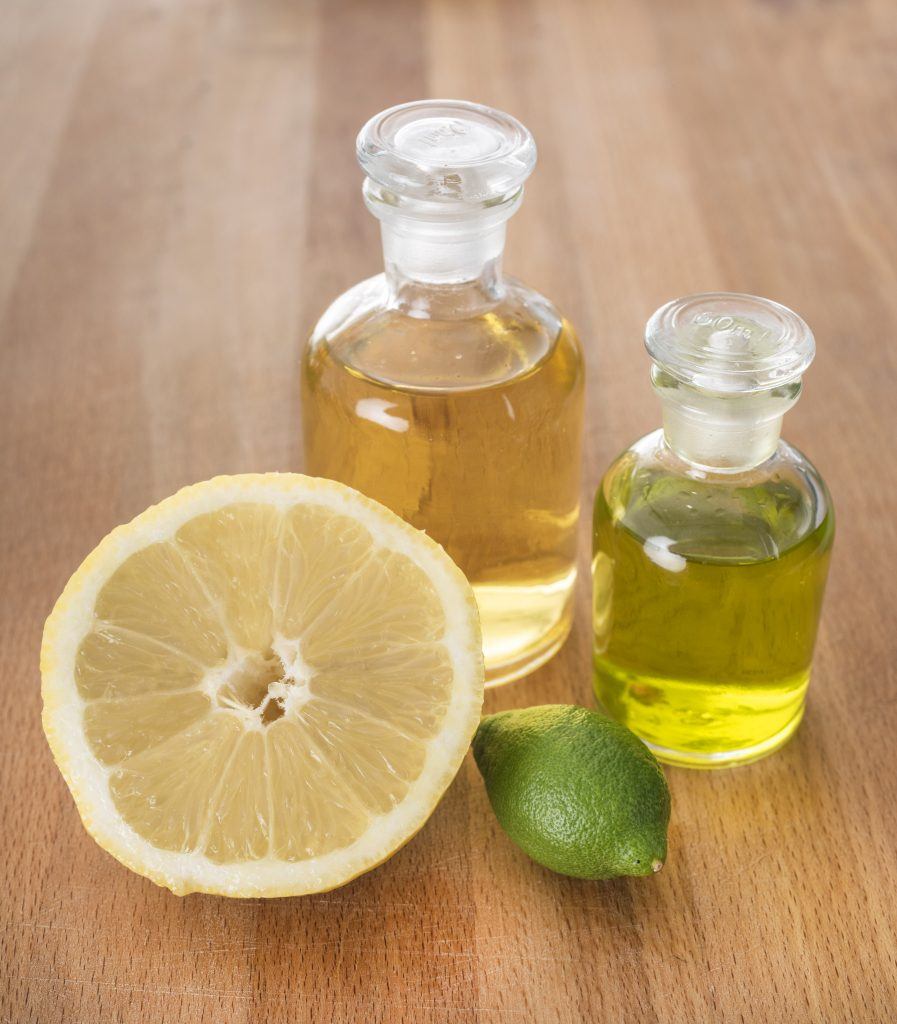When we think about limes, we might think about fresh margaritas or small islands in the Florida Keys. While those are both excellent uses of limes, they also give rise to an essential oil that is powerful and smells delicious. Limes are a fantastic fruit that produces impressive benefits for health and wellness!
In this article, we’ll give you a background on lime essential oil, complete with the history of lime, its chemical properties, and why all citrus essential oils should be a staple in your essential oil toolkit.
Then, we’ll talk about the general health benefits of lime, its benefits to the skin, and the different uses of lime essential oil. We’ll go over what you should look for in a high-grade lime essential oil and answer some frequently asked questions about lime essential oil.
So let’s dive in and check out all of the ways that lime essential oil can benefit us!
Table of Contents
A Description of Lime Essential Oil
Lime essential oil has a bright and delicious scent, and is either a pale yellow or light olive color, depending on how it is produced. It is most prominently used as a flavoring agent in food, but in fact, has many other well-known uses! From health benefits to practical uses around the house, lime essential oil really can do it all. Plus, it has a warm and inviting citrus scent that is great for aromatherapy. Let’s check out the history of lime and some of the science behind this oil and other citrus essential oils.
The History of Lime

It is estimated that wild limes originated in Indonesia or the nearby mainland of Asia over a thousand years ago. The spread of the lime across the world was likely made possible by traders and explorers. First, the Arabian traders who may have taken limes and lemons from India to the nations of the eastern Mediterranean and Africa in around 1000CE. Then, the Crusaders who invaded western Europe in the 12th and 13th centuries, then Christopher Columbus who took citrus seeds (which most likely included limes) to the West Indies in 1493.
Lastly, lime trees became widespread in the West Indies, Mexico, and Florida, where they are all still present today.
Limes and Scurvy
Limes played an essential role in early exploration because of their high Vitamin C content. Vitamin C prevents scurvy, a disease that causes uncomfortably swollen and bleeding gums and poor wound healing as the result of a Vitamin C deficiency. Limes and other citrus fruit played a substantial role in preventing scurvy among early explorers until around the end of the 18th century.
Types of Limes

The term “lime” covers any of the several species of trees and shrubs that are in the “rue” scientific grouping, which is also known as Rutaceae. Rutaceae trees and shrubs are widely grown in tropical and subtropical areas and are known for their edible and acidic fruit.
Persian limes are one of the most common limes that you have most likely seen at your local grocery store. The smaller Mexican lime (also known as the Key Lime) is available and economically important in many locations as well.
The lime tree itself is pretty short for a tree and doesn’t usually grow to be more than 16 feet high. If it is not pruned, it resembles more of a shrub. It has branches that spread wide and are irregular, often containing short and stiff twigs along with small leaves and many small and sharp thorns. Lime trees have pale green evergreen leaves and small white clusters of flowers.
Lime Essential Oil Distilled Versus Cold-Pressed
Now that we’ve covered the history of lime let’s get into the essential oil form of this fruit. Lime essential oil is either distilled or made using expression or cold pressing methods with the peels of the lime. It is thought to be more desirable to use expression or cold pressing when making citrus essential oils because it offers a more intense citrus aroma than distillation.
There are always pros and cons to distillation vs. cold pressing oils from fruit. Cold pressing creates such a lovely citrus smell because there is more waxy residue from the skin of the lime when it is produced into an essential oil.
Distilled citrus oil does not contain these residues, which may have the potential to clog diffusers, stain fabrics, and shorten the shelf life of this essential oil. Distilled citrus oils are also considered to be less photosensitive than cold-pressed citrus essential oils, meaning that exposure to sunlight may cause the oil to go bad faster if it is cold-pressed. One precaution to take if you do choose to use a cold-pressed lime essential oil is to avoid sun exposure if you are using it on your skin because it can cause burning and potentially damage your skin.
Chemical Properties

The most important part of lime essential oil is the chemical properties that give it its amazing benefits! The chemicals that occur most abundantly in lime are citral, limonene, beta-pinene, and fenchone. Citral is a combination of aromatic chemical compounds that have proven anti-bacterial and anti-fungal benefits. In one study, citral was deemed a viable option for food and cosmetic preservation because of its ability to both kill and limit regrowth of Eschera coli in test samples.
Limonene
Limonene is a chemical compound that is in a lot of citrus fruits. You can impress your friends with your chemistry knowledge by sharing that limonene is a cyclic monoterpene that is used in fragrance and food flavoring. Not only does this chemical compound smell pleasant, but it also has proven antimicrobial activity. In one study, limonene reduced the growth of bacteria and fungus in a petri dish, which is a promising indicator that this chemical compound can have this effect in humans as well.
Beta-Pinene
Beta-pinene is a monoterpene, which is just an organic compound that occurs in plants like limes. You may have heard the word “terpene” before when referencing cannabis. This is because terpenoid compounds in cannabis are similar to those in essential oils – they’re both plants after all! Terpenes not only give cannabis (and all essential oils) their unique scents, they also produce medicinal effects.
Lime is no different. The monoterpene beta-pinene gives lime its woodsy type scent and also is part of what makes it into a bacteria killer! In one study, beta-pinene was shown to have an inhibitory effect on the growth of bacteria when tested against a popular anti-bacterial drug.
Fenchone
Fenchone is another monoterpene that occurs naturally in limes and lime essential oil and also has exciting and useful benefits as an analgesic. One study showed that fenchone had antinociceptive effects in tests on mice, meaning that typical pain responses were reduced.
While these are the main chemical components of lime, there are also terpenoids like terpineol and bisabolene, among others. Terpenoids serve a lot of functions in plants but are aromatic compounds in the case of lime.
The Role of Citrus Essential Oils

Citrus fruits are used in traditional eastern medicine to cure a variety of diseases. Citrus-derived essential oils contain potent metabolites like flavonoids, alkaloids, limonoids, and many more that are of vital importance to human health based on their healing properties. Their characteristics range from anti-oxidative, anti-inflammatory, antimicrobial, all the way to cardioprotective and neuroprotective.
It’s safe to say that all citrus essential oils have positive effects on health and wellness, but they can also be used as a component of household cleaning products and have a role in aromatherapy too!
Citrus essential oils share common flavonoids and terpenoids that deliver similar effects. You’ll find that many of the health benefits of lime essential oil appear in orange and lemon essential oils as well. This is because citrus fruits have a unique combination of phytochemicals that deliver incredible results.
What are the Health Benefits of Lime?
Lime essential oil is thought to have many potential health benefits, mainly because of the presence of phytochemicals like limonene. You’ll find below that limonene is responsible for a lot of the positive health benefits of lime and citrus in general! These are just a few of the significant benefits of lime essential oil. Lime essential oil’s benefits are thought to be very broad and are continually being researched. Lime can be used externally and internally and is generally considered to be non-toxic, so it has a wide application! Let’s dig into some of the health benefits of lime essential oil.
Lime May Improve Heart Health

Heart disease is one of the most prevalent health problems in the world today. In 2013 it was estimated to be responsible for approximately 3.14% of deaths, which makes it the leading cause of death.
While lime isn’t a silver bullet for heart disease, studies have shown that chemical compounds in lime have been effective at slowing the buildup of plaque on the walls of the arteries, known as atherosclerosis [11]. Of course, we have to take into consideration a balanced lifestyle, including a healthy diet and regular exercise, along with genetic factors, but this is a promising benefit of lime essential oil.
May Help Fight Cancer Cells
Antioxidants are chemical compounds that have been proven to fight against free radicals that cause cell damage and chronic disease. Lime essential oil contains a concentrated amount of antioxidants in the form of phytochemicals like flavonoids, flavones, triterpenoids, and limonoids.
Additionally, other compounds found in limes were shown to suppress tumor cells in a scientific study. This compound that was extracted from lime was shown to block the growth of these colon cancer cells by 67% after just 72 hours. Other studies indicate that components of lime can reduce the strength of breast cancer cells. Although, not a definitive treatment for cancer, lime essential oil, and its components are providing opportunities for scientific research.
May Enhance Weight Loss
This statement is a more observed effect of lime essential oil but is still worth mentioning. One scientific study supports the assertion that lime essential oil can assist with weight loss based on an experiment conducted with mice. However, the weight loss that was achieved with the mice was not ultimately confirmed to be caused by the lime oil.
Lime’s use as a food flavoring agent may be part of the reason it has a reputation for weight loss. By replacing sugary flavors with lime oil, individuals can save calories and still enjoy a fresh citrus flavor. Of course, this practical usage is effective in conjunction with an overall healthy diet and exercise, so keep this in mind if you plan to leverage lime for weight loss.
May Boost Immunity
Due to the high concentration of limonene in lime essential oil, it is thought that lime can boost immunity as well! Keep in mind that this is conjecture based on the known qualities of limonene.
Lime has also been known to kill off potential infections. Several studies point to lime and its compounds producing anti-bacterial effects when tested against different pathogens. One such pathogen was even Cholera, against which lime reduced the number of affected cells.
We do know that Vitamin C helps maintain a robust immune system, so even if you don’t buy into the benefits of lime essential oil, you can still reap the benefits of lime from the juice!
If you choose to use lime essential oil for immunity, take a drop of high-grade lime essential oil and mix one drop with a teaspoon of honey. Use raw honey to get the added benefits of raw honey as well!
Aromatherapy
Citrus essential oils overall are observed to have a calming effect when diffused. Lime essential oil is no different! One study used citrus essential oils to test whether individuals going into surgery felt calmer when they inhaled citrus essential oil first, and the results pointed to the potential calming effects of citrus essential oils. Diffuse a few drops of lime essential oil before bed to experience the calming benefits of this essential oil.
Benefits to the Skin
Lime Essential Oil and Acne

The high concentration of antioxidants in lime essential oil makes it a more natural option for anti-aging and the treatment of acne.
Just like its cousins lemon and orange, lime essential oil can be safely used on the skin to aid in conditions like acne. The natural antimicrobial activity of lime makes it perfect for this purpose.
To utilize lime essential oil for acne, mix a few drops with witch hazel, then use a cotton ball to wipe it across problem areas. Remember, first, to do a small patch test with this essential oil before you put it all over your face just in case you experience any adverse effects.
Also, if you are comfortable with using coconut oil on your face, you can mix a few drops with coconut oil and apply. Coconut oil has natural antimicrobial activity, plus you’ll smell like you just came from a day in the tropics! As a bonus for acne sufferers, lime is considered to be anti-bacterial and can help reduce the amount of acne-causing bacteria on the face. Plus, using this before bed can help you go to sleep with a renewed sense of calm.
Anti-aging Benefits
To use lime essential oil for anti-aging, mix a few drops in your favorite moisturizer, and apply as usual. For both of these uses, be sure to avoid the eye area. Citrus is terrific for the skin, but it will sting your eyes if you accidentally touch them with citrus oil on your hands!
To use lime essential oil on areas of the skin other than your face, always be sure that you are using a carrier oil! We mentioned coconut oil as one option, but you could also use jojoba or avocado oil. Applying jojoba oil with a few drops of lime essential oil and even a few drops of lavender would make for a relaxing and comforting post-bath moisturizer.
Different uses for Lime Essential Oil
There are several observed uses for lime essential oil that go beyond the human body! You can use it as part of a household cleaner, to repel insects, even to remove stains.
Household Cleaner
To use it as a household cleaner, mix about 20 drops with a half cup of water and a half cup of vinegar in a spray bottle. This mixture will disinfect surfaces and leave behind a fresh, clean scent.
Repels Insects
To repel insects inside your house, you can mix about ten drops of lime essential oil with two cups of water and spray it where you usually have issues with bugs getting in, and prevent any potential bug bites. You can also spray it onto your clothes if you are going to be outside, but be careful not to use cold-pressed lime essential oil because contact with your skin could cause burning when exposed to sunlight.
Stain Remover
Lime essential oil can remove grease stains and sticker residue, but be sure to patch test the area you would like to remove stains from first to make sure that it doesn’t leave another stain.
Flavor Agent

If you are using a high-quality therapeutic grade lime essential oil, you can also use lime essential oil to flavor recipes! Imagine adding an extra kick of lime flavor to your next citrus dessert!
Precautions and Tips for Using Lime Essential Oil
Lime essential oil is usually considered to be non-toxic and doesn’t usually produce irritation or allergies, so it is typically safe for internal, external, and aromatic uses.
Importance of a Patch Test
However, everyone is different! We always recommend using a carrier oil to dilute essential oils before you apply them topically. Even if you aren’t allergic to the essential oil, using an undiluted oil can produce skin irritation. One option that sounds particularly good is coconut oil. Coconut oil has antimicrobial activity and a lovely coconut scent that would mix well with lime. Don’t forget to do a patch test with your diluted essential oil as well – don’t assume that just because it is diluted, you won’t have any type of reaction. If it’s your first time using an oil, always proceed with caution.
High Quality Lime Essential Oil
We also always recommend getting essential oils that are Certified Organic by the USDA, especially if you plan on using the oil internally. Here is our favorite organic lime essential oil.
Precaution of Phototoxicity
Lime essential oil, in particular, comes with the added precaution of phototoxicity. This means that when exposed to sunlight, some lime essential oils will burn the skin. If you have a cold-pressed lime essential oil, this is a higher risk. It is best to make sure that you don’t venture out into the sun for at least 12 hours after you use a cold-pressed lime essential oil topically to make sure that you don’t damage your skin!
Use these precautions and your own best judgment, and you will love using your lime essential oil!
